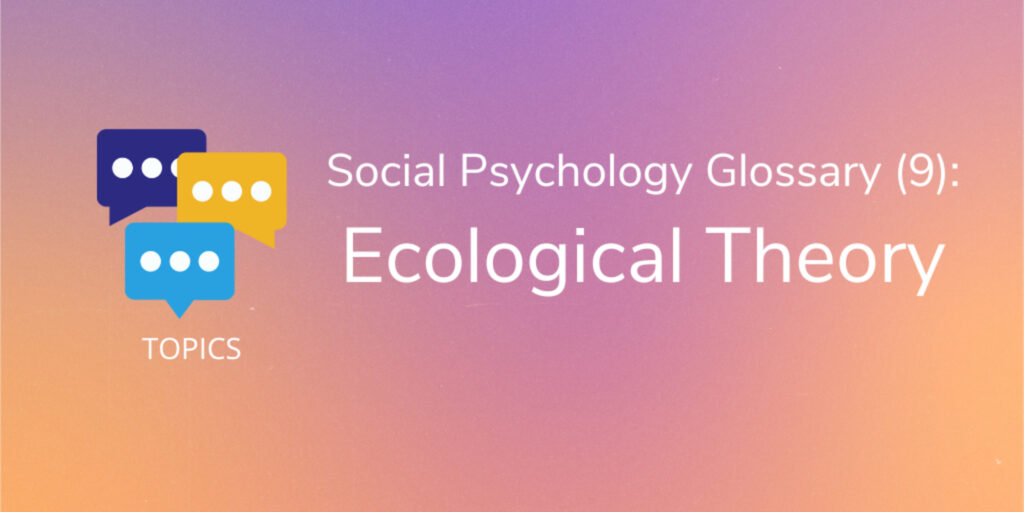Welcome to the Social Psychology Glossary!
In these posts, I will explain Social Psychology terms and theories and add some examples from research.
These terms and theories help social psychologists understand how people perceive others, interact with them, and make judgments about the social world and its members. These psychological processes can impact well-being and decision-making: being aware of their existence is a key factor that helps individuals and society to move towards gender diversity, gender equality, and equality in general.
Today we will explain what the Ecological Theory is.
Ecological Systems Theory
Despite the name, Bronfenbrenner’s Ecological Systems Theory did not focus on all biological elements within the environment. Urie Bronfenbrenner was, in fact, a psychologist. He focused on how the environment that surrounds a person influences their development, and the specific topic of his work was the development of children.
Before Bronfenbrenner, the development of children was mostly investigated with biological perspectives. Growth was seen as the outcome of biological elements only. Bronfenbrenner, instead, realized that the development of children was influenced by the social, economic, physical, and political environment that surrounded them. The school the kids went to, whether it was easy for them (and their parents) to join social activities, whether the country financially helped families: all these things can influence the growth of a child.
Bronfenbrenner’s Theory now comprises 5 systems (although he theorized only 4 systems at the beginning). Each system is a level of analysis of the environment. The systems go from narrower to broader, and they influence each other. Here is a brief overview:
- Microsystem: the microsystem includes everything that directly influences the person. For example, the parents influence their child.
- Mesosystem: in the mesosystem we consider the relationships between various microsystems that surround the child. For example, we can look at the relationships between parents and school. The parents might get along well with the teachers, but the parent-teachers relationship might also be difficult. The kind of relationship can impact the development of a kid.
- Exosystem: the exosystem includes the systems that influence the microsystems. For example, a job might be very taxing for a parent, so the parents have little time for the kid and this can influence the child.
- Macrosystem: the macrosystem includes all the cultural factors, policies, social structures and beliefs that influence the person. For example, belonging to an ethnic minority can influence a child because this minority can be discriminated or even privileged in a given society.
- Chronosystem: the chronosystem considers how events influence the person depending on the moment they are living, external circumstances and life stage. For example, the divorce of the parents can have a different influence depending on the age and life stage of the child.
These systems offer a perspective to analyze a phenomenon. Explanations can be attributed to the individual level, but sometimes the roots of a phenomenon are at a different or multiple levels (to know more about attributions, you might read our posts about Attribution or Attributional and Exploratory Styles). It is similar when we want to find solutions. Personal resilience – discussed in our last post – is a solution at the individual level, but sometimes stronger solutions can be found on a different level, or with the synergy of different levels. Even our PhD projects look at issues related to gender and sexuality in different systems. Project 1 focuses on how gender stereotypical beliefs of the parents and their influence on the child’s choices, and this is a microsystem perspective. Project 13, instead, examines how organizational climate impacts gender diversity, and this relationship is at the macrosystem level. To target an issue, it’s always more thorough to consider several perspectives.
When analyzing a phenomenon, it is important to be aware of our reasoning processes, because we can make fast judgments – shortcuts – that are mostly correct but that are not always accurate. These processes of thought are called heuristics, and they will be the topic of our next post.
Suggested Readings
Bronfenbrenner, U. 1979. The ecology of human development: Experiments by nature and design. Cambridge: Harvard University Press.
Bronfenbrenner, U., and S.J. Ceci. 1994. Nature-nurture reconceptualized in developmental perspective: A bioecological model. Psychological Review 101 (4): 568–586.

Train the sponsor — Implementation of a new mentoring training (UK)
